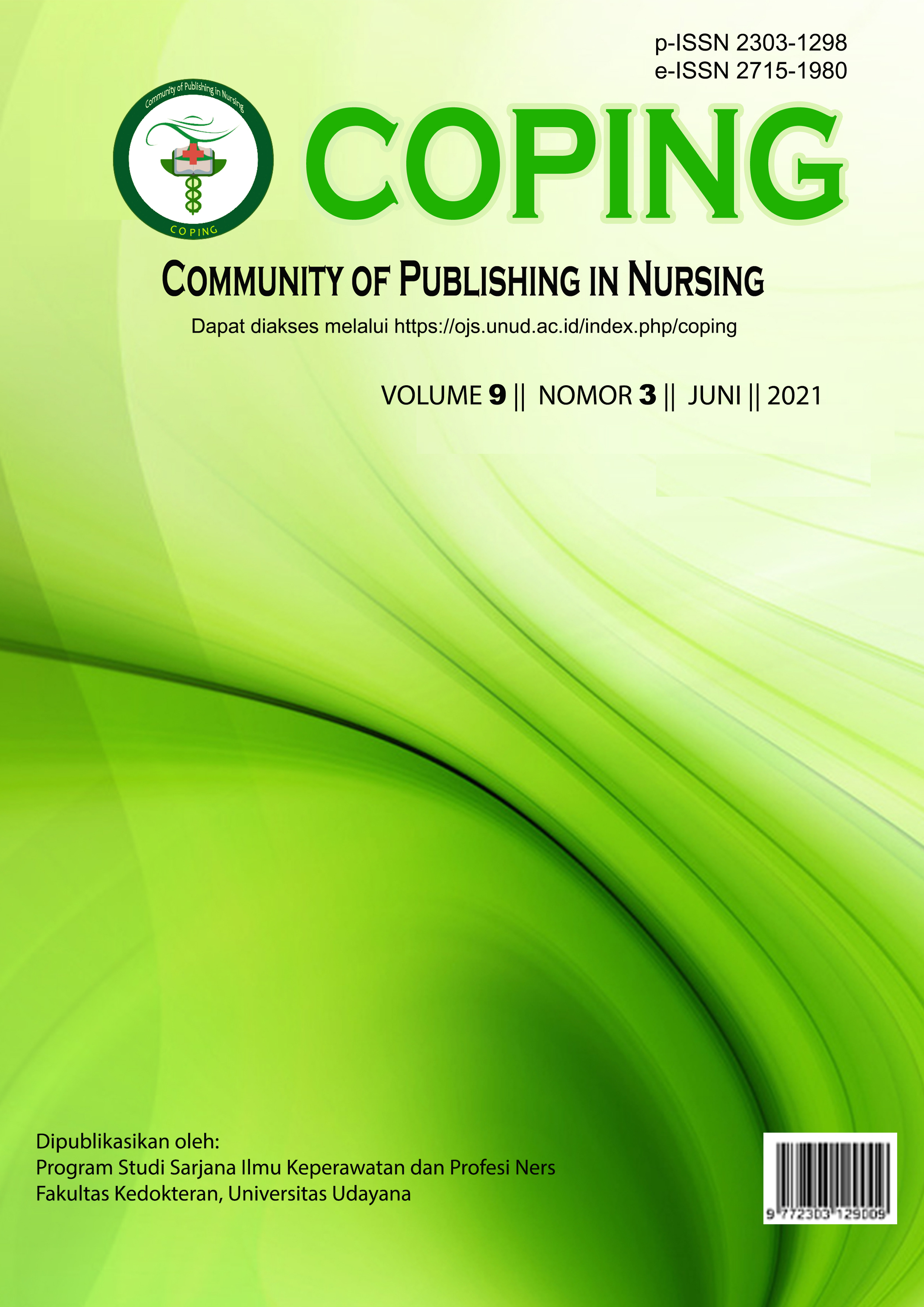HUBUNGAN ANTARA HEALTH LOCUS OF CONTROL DENGAN KEPATUHAN MENJALANI TERAPI HEMODIALISIS PADA PASIEN GAGAL GINJAL TERMINAL
Abstrak
Gagal Ginjal Terminal (GGT) didefinisikan sebagai penyakit ginjal kronis yang memiliki karakteristik berupa penurunan laju filtrasi glomerulus hingga <15 ml/min/1,73m2 dan bersifat irreversible. Upaya yang dapat dilakukan untuk mempertahankan kelangsungan hidup pasien adalah dengan melakukan terapi hemodialisis secara patuh. Health Locus of Control (HLC) didefinisikan sebagai suatu faktor yang memberikan pengaruh pada kepatuhan pasien dalam menjalani terapi hemodialisis. Penelitian ini ditujukan untuk mengidentifikasi hubungan diantara health locus of control dengan kepatuhan pasien gagal ginjal terminal dalam menjalani terapi hemodialisis. Penelitian deskriptif korelatif disertai pendekatan cross-sectional menjadi desain penelitian ini. Responden sebanyak 100 orang diperoleh melalui teknik purposive sampling. Spearman Rank dilakukan untuk memperoleh analis data. Hasil penelitian menunjukkan terdapat hubungan positif lemah antara internal HLC dengan kepatuhan menjalani terapi hemodialisis (r=0,236; p value=0,018; ?=0,05), terdapat hubungan positif sedang antara powerful others HLC dengan kepatuhan menjalani terapi hemodialisis (r=0,416; p value=0,001; ?=0,05) dan tidak terdapat hubungan antara chance HLC dengan kepatuhan menjalani terapi hemodialisis (p value=0,564; ?=0,05). Penelitian ini diharapkan bisa menjadi pedoman bagi perawat dalam melakukan tindakan yang bertujuan untuk meningkatkan kepatuhan pasien dalam menjalani terapi hemodialisis yang mengacu pada health locus of control.
##plugins.generic.usageStats.downloads##
Referensi
Bener, A. (2011). High Prevalence of Depression, Anxiety and Stress Symptoms Among Diabetes Mellitus Patients. The Open Psychiatry Journal, 5(1), 5–12. https://doi.org/10.2174/1874354401105010005
Bolman, C., Arwert, T. G., & Völlink, T. (2011). Adherence to prophylactic asthma medication: Habit strength and cognitions. Heart & Lung, 40(1), 63–75. https://doi.org/10.1016/j.hrtlng.2010.02.003
Caninsti, R. (2013). Kecemasan dan Depresi pada Pasien Gagal Ginjal Kronis yang Menjalani Terapi Hemodialisis. Jurnal Psikologi Ulayat, 1, 16.
Fithria, F., & Isnaini, M. (2014). Faktor-faktor yang berhubungan dengan kepatuhan berobat pada penderita hipertensi di klinik Sumber Sehat Indrapuri Aceh Besar. Idea Nursing Journal, 5(2), 56-66.
Ghimire, S., Peterson, G. M., Castelino, R. L., Jose, M. D., & Zaidi, S. T. R. (2016). Medication Regimen Complexity and Adherence in Haemodialysis Patients: An Exploratory Study. American Journal of Nephrology, 43(5), 318–324. https://doi.org/10.1159/000446450
Grotz, M., Hapke, U., Lampert, T., & Baumeister, H. (2011). Health locus of control and health behaviour: Results from a nationally representative survey. Psychology, Health & Medicine, 16(2), 129–140. https://doi.org/10.1080/13548506.2010.521570
Hudak, C. M., & Gallo, B.M. (2010). Keperawatan kritis: Pendekatan holistic (6th ed.) Jakarta: EGC
INDONESIAN RENAL REGISTRY. (2017). 40.
Izzati, W., & Annisha, F. (2016). Faktor-Faktor yang Berhubungan dengan Kepatuhan Pasien yang Menjalani Hemodialisis di Ruang Hemodialisa Di RSUD Dr. Achmad Mochtar Bukittinggi Tahun 2015. 3, 30.
Kammerer, J., Garry, G., Hartigan, M., Carter, B., & Erlich, L. (2007). Adherence in Patients On Dialysis: Strategies for Success. NEPHROLOGY NURSING JOURNAL, 34(5), 10.
Kemenkes (Riskesdas). (2013)
Kemenkes (Riskesdas Bali). (2013).
Kim, Y., & Evangelista, L. S. (2011). Relationship between Illness Perceptions, Treatment Adherence, And Clinical Outcomes in Patients On Maintenance Hemodialysis. 18.
Klinovszky, A., Kiss, I. M., Papp-Zipernovszky, O., Lengyel, C., & Buzás, N. (2019). Associations of different adherences in patients with type 2 diabetes mellitus. Patient Preference and Adherence, Volume 13, 395–407. https://doi.org/10.2147/PPA.S187080
National Kidney Foundation. (2019). Kidney failure: A to z health guide. In New York: National Kidney Foundation, Inc., p.8. Retrieved from https://www.kidney.org/atoz/content/KidneyFailure.
Niven, N. (2012). Psikologi pengantar untuk perawat dan profesional kesehatan lain (2nd ed.). Jakarta: EGC.
Nuraini, A. (2013). Hubungan antara Self-Efficacy dengan Health Locus of Control pada Penderita Diabetes Mellitus Tipe 2 Anggota Perkumpulan Senam Diabetes di Puskesmas Pakis Surabaya. 2(1), 6.
Nurlatifah. (2018). Hubungan Health Locus Of Control dengan Kepatuhan Pengobatan pada Pasien Penyakit Kronis: Kanker di Medan.
Ozen, N., Cinar, F. I., Askin, D., Mut, D., & Turker, T. (2019). Nonadherence in Hemodialysis Patients and Related Factors: A Multicenter Study. 27(4), 11.
Pramesti, A. D. (2019.). Program Studi Psikologi Fakultas Psikologi dan Ilmu Sosial Budaya Universitas Islam Indonesia Yogyakarta. 144.
Price & Wilson. (2012). Patofisiologi: Konsep klinis proses-proses penyakit. Volume 2. EGC. Jakarta.
Qobadi, M., Besharat, M. A., Rostami, R., & Rahiminezhad, A. (2015). Health Literacy and Medical Adherence in Hemodialysis Patients: The Mediating Role of Disease-Specific Knowledge. Thrita, 4(1). https://doi.org/10.5812/thrita.26195
Safitri, I. N. (2013). Kepatuhan Penderita Diabetes Mellitus Tipe Ii ditinjau dari Locus of Control. 01, 18.
Schultz, D. P., & Schultz, S. E. (2012). Theories of Personality. THEORIES of Personality, 500.
Siddiqui, M., Khan, M., & Carline, T. (2013). Gender Differences in Living with Diabetes Mellitus. Materia Socio Medica, 25(2), 140. https://doi.org/10.5455/msm.2013.25.140-142
Smeltzer, S.C. & Bare, B.G. (2013). Buku ajar keperawatan medikal bedah Brunner & Suddarth (8th ed.). Jakarta : EGC.
Sudoyo. (2014). Buku Ajar Ilmu Penyakit Dalam (6th ed.). Jakarta: Interna:1035-37.
Suwitra. (2014). Penyakit ginjal kronik. Buku Ajar Ilmu Penyakit Dalam Jilid II (6th ed.). Jakarta: FKUI.
Syamsiah, N. (2011). Fakultas Ilmu Keperawatan Program Studi Magister Keperawatan Kekhususan Keperawatan Medikal Bedah Universitas Indonesia Depok, Juli 2011. 142.
USRDS. (2017). Chapter 1: Incidence, Prevalence, Patient Characteristics and Treatment Modalities. Volume 2: ESRD in the United States.
ESRD (2018). Chapter 1: Incidence, prevalence, patient characteristics and treatment modalities. 2, 412.
Wallston, K. A., & Wallston, B. S. (1981). Health Locus of Control Scales. In Research with the Locus of Control Construct (pp. 189–243). Elsevier. https://doi.org/10.1016/B978-0-12-443201-7.50010-5
Wulandari Priyanti. (2015.) Pengaruh Illnes Perception, Dukungan Sosial, dan Health Locus of Control terhadap Kepatuhan pada Pasien Gagal Ginjal Kronik. Jurnal Universitas Paramadina, 12(1), 1253-1288.








